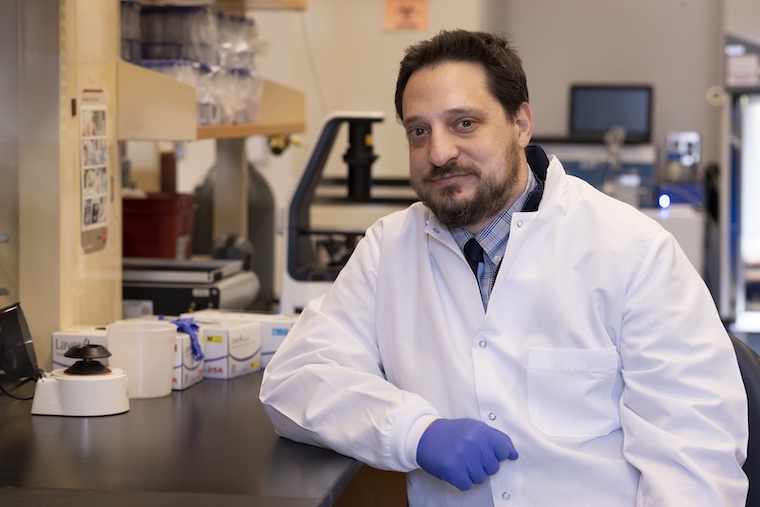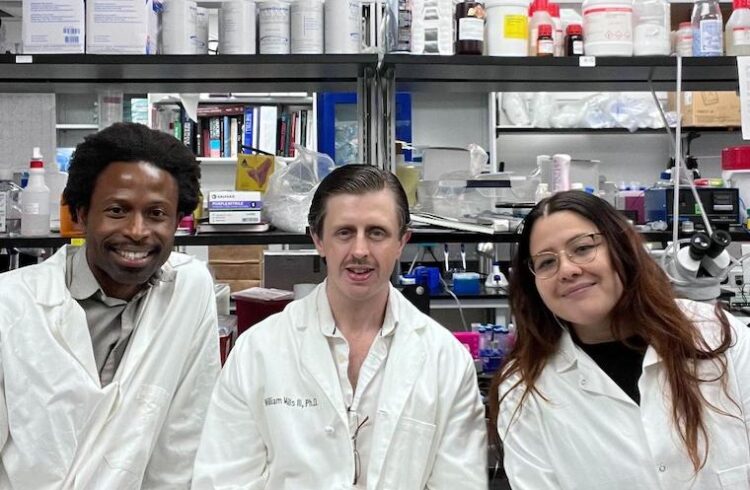
Bradley Gelfand, PhD, is giving us new insights into macular degeneration and other causes of vision loss.
An antidepressant best known as Prozac could offer the first treatment for the leading cause of blindness among people over 50, new research from the University of Virginia School of Medicine suggests.
UVA’s Bradley D. Gelfand, PhD, and collaborators have found early evidence that the drug fluoxetine may be effective against atrophic (or “dry”) age-related macular degeneration, a condition that affects nearly 200 million people worldwide. The drug has shown promise in the scientists’ lab tests and animal models, and the researchers bolstered by their results by examining two huge insurance databases encompassing more than 100 million Americans. That analysis concluded that patients taking fluoxetine were less likely to develop atrophic macular degeneration (AMD).
Based on their findings, the researchers are urging clinical trials to test the drug in patients with AMD. If successful, they believe the drug could be administered either orally or via a long-lasting implant in the eye.
“These findings are an exciting example of the promise of drug repurposing, using existing medicines in new and unexpected ways,” said Gelfand, of UVA’s Center for Advanced Vision Science. “Ultimately, the best way to test whether fluoxetine benefits macular degeneration is to run a prospective clinical trial.”
Fluoxetine and Blindness
The researchers believe fluoxetine works against AMD by binding with a particular agent of the immune system known as an inflammasome. This inflammasome, NLRP3-ASC, triggers the breakdown of the pigmented layer of the eye’s retina.
After conducting extensive bench research, Gelfand and his team tested fluoxetine and eight other depression drugs in lab mice to see what effect, if any, the drugs would have in a model of AMD. Fluoxetine slowed the progression of the disease, but the others did not, the scientists found.
Encouraged by their findings, the researchers looked at fluoxetine use among patients over age 50 in two enormous insurance databases. People taking the drug had a “significantly” slower rate of developing dry AMD, the researchers report in a new scientific paper outlining their findings.
They note that their approach, combining bench research with big-data analysis, could potentially facilitate the repurposing of existing drugs for many conditions, speeding new treatments to patients.
“Traditional approaches to drug development can be expensive and time-consuming: On average, a new FDA-approved drug takes 10-12 years and costs $2.8 billion (present-day dollars) to develop,” the researchers wrote. “Our identification of the unrecognized therapeutic activity of an existing FDA-approved drug using big data mining, coupled with demonstrating its efficacy in a disease-relevant model, could greatly accelerate and reduce the cost of drug development.”
Gelfand was involved earlier this year in using a similar approach to determine that HIV drugs known as nucleoside reverse transcriptase inhibitors, or NRTIs, may be useful against dry macular degeneration as well.
“While we have had a great deal of success with the approach of using real-world patient data, we may have only begun to scratch the surface of finding new uses for old drugs,” said Gelfand, of UVA’s departments of ophthalmology and biomedical engineering. “It is tempting to think about all the untapped therapeutic potential of medicines sitting on pharmacy shelves.”
Findings Published
The researchers have published their findings in the scientific journal PNAS. The first author of the paper is Meenakshi Ambati, a senior at Albemarle High School who won several national and international science competition awards for the work. As a volunteer in Gelfand’s laboratory, she initially employed bench laboratory techniques. When the pandemic all but shut down normal laboratory operations, she was able to continue working on computational analyses, which ultimately gave the overall study its multi-pronged approach.
The other members of the research team include Ivana Apicella, Shao-bin Wang, Siddharth Narendran, Hannah Leung, Felipe Pereira, Yosuke Nagasaka, Peirong Huang, Akhil Varshney, Kirstie L. Baker, Kenneth M. Marion, Mehrdad Shadmehr, Cliff I. Stains, Brian C. Werner, Srinivas R. Sadda, Ethan W. Taylor, S. Scott Sutton and Joseph Magagnoli.
Gelfand and other researchers involved in the work are named as inventors on patent applications on macular degeneration filed by UVA. Gelfand is also a co-founder of DiceRx, a startup pharmaceutical company. A full list of the researchers’ disclosures is included in the paper.
The research was supported by the UVA Strategic Investment Fund; National Institutes of Health grants R01EY028027, R01EY031039, R01EY032512 and R35GM119751; BrightFocus Foundation; the Owens Family Foundation; and UVA.
UVA’s Department of Biomedical Engineering is a joint collaboration of UVA’s School of Medicine and School of Engineering.To keep up with the latest medical research news from UVA, subscribe to the Making of Medicine blog.
MORE FROM GELFAND: Exercise can slow or prevent vision loss, research suggests.



